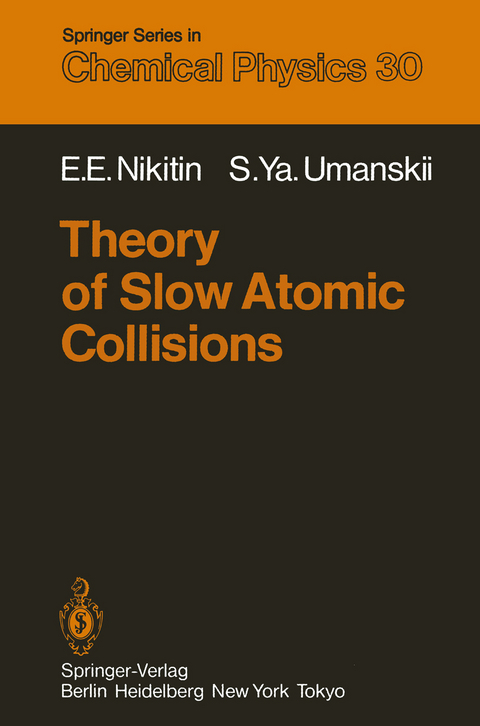
Theory of Slow Atomic Collisions
Springer Berlin (Verlag)
978-3-642-82047-2 (ISBN)
1. Introduction.- 2. General Formulation of Scattering Problem Under Quasi-Classical Conditions.- 2.1 Scattering Amplitudes and Cross Sections.- 2.2 Scattering Equations.- 2.3 Collisions of Two Many-Electron Atoms.- 2.4 Integral Cross Sections for Isotropic Collisions.- 3. Diatomic Electronic States.- 3.1 Quantum Numbers and Wave Functions of a Free Atom..- 3.2 Quantum Numbers and Wave Functions of Diatoms.- 3.3 Adiabatic States, Diabatic States, and Correlation Diagrams.- 3.4 Coupling Between Electronic States. Selection Rules.- 4. Approximate Calculation of the Electronic States of Diatoms.- 4.1 Atomic Potential and Atomic Orbitals.- 4.2 Diatomic Interactions at Large Distances and the Heitler-London Approximation.- 4.3 Pseudopotential Method for Interatomic Interactions.- 4.4 Short-Range Atomic Interactions.- 4.5 Coupling Between Electronic States.- 5. Elastic Scattering.- 5.1 Quasi-Classical Scattering Amplitude.- 5.2 Quasi-Classical Scattering Matrix.- 5.3 Classical Scattering.- 5.4 Integral Cross Sections.- 5.5 Differential Cross Sections.- 6. Approximate Calculation of a Multichannel Quasi-Classical Scattering Matrix.- 6.1 Common-Trajectory Approach.- 6.2 Matching Approach.- 6.3 Perturbation Approach.- 7. Two-State Scattering Problem.- 7.1 The Two-State Model. Adiabatic and Diabatic Representations.- 7.2 Construction of the Two-State Quasi-Classical S Matrix by the Matching Method.- 7.3 Two-State Semiclassical Models.- 7.4 Differential Cross Sections and Deflection Functions.- 8. The Linear Two-State Landau-Zener Model.- 8.1 Formulation of the Model.- 8.2 Nonadiabatic Transitions Far from the Turning Point. Landau-Zener-Stueckelberg Solution.- 8.3 Nonadiabatic Transitions Near the Turning Point.- 8.4 Validity of Linear Model and of Analytical Expressions for Transition Probabilities.- 8.5 Cross Sections for the Linear Model.- 9. Nonlinear Two-State Models of Nonadiabatic Coupling.- 9.1 Exponential Model.- 9.2 Linear-Exponential Model.- 9.3 Other Nonlinear Models.- 10. Multistate Models of Nonadiabatic Coupling.- 10.1 Transitions Between Degenerate States.- 10.2 Transitions Between Highly Excited States.- 10.3 Generalizations of the Linear Model.- 11. Case Study - Intramultiplet Mixing and Depolarization of Alkalis in Collisions with Noble Gases.- 11.1 Formulation of the M* - X Scattering Problem.- 11.2 The Scattering Matrix.- 11.3 Transition Probabilities and Cross Sections for Isotropic Collisions.- A. Quantum Theory of Angular Momentum.- A. l Rotation Matrices and Spherical Functions.- A.2 Coupling of Angular Momenta, Clebsch-Gordan.- A.3 Matrix Elements of the Irreducible Tensor.- Operators.- References.
| Erscheint lt. Verlag | 22.12.2011 |
|---|---|
| Reihe/Serie | Springer Series in Chemical Physics |
| Zusatzinfo | XII, 434 p. |
| Verlagsort | Berlin |
| Sprache | englisch |
| Maße | 155 x 235 mm |
| Gewicht | 679 g |
| Themenwelt | Naturwissenschaften ► Physik / Astronomie ► Atom- / Kern- / Molekularphysik |
| Schlagworte | atomic collision • chemical physics • Collision • Molecule |
| ISBN-10 | 3-642-82047-6 / 3642820476 |
| ISBN-13 | 978-3-642-82047-2 / 9783642820472 |
| Zustand | Neuware |
| Haben Sie eine Frage zum Produkt? |
aus dem Bereich


